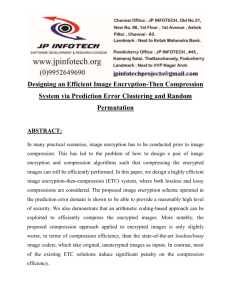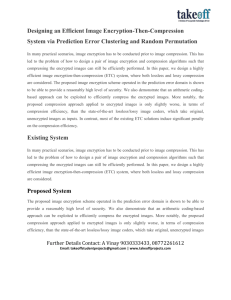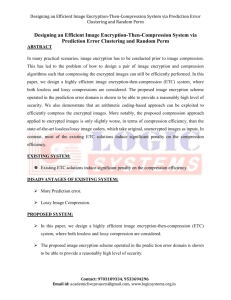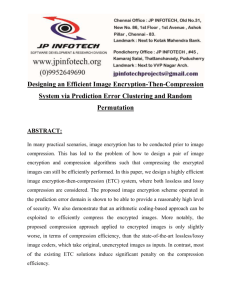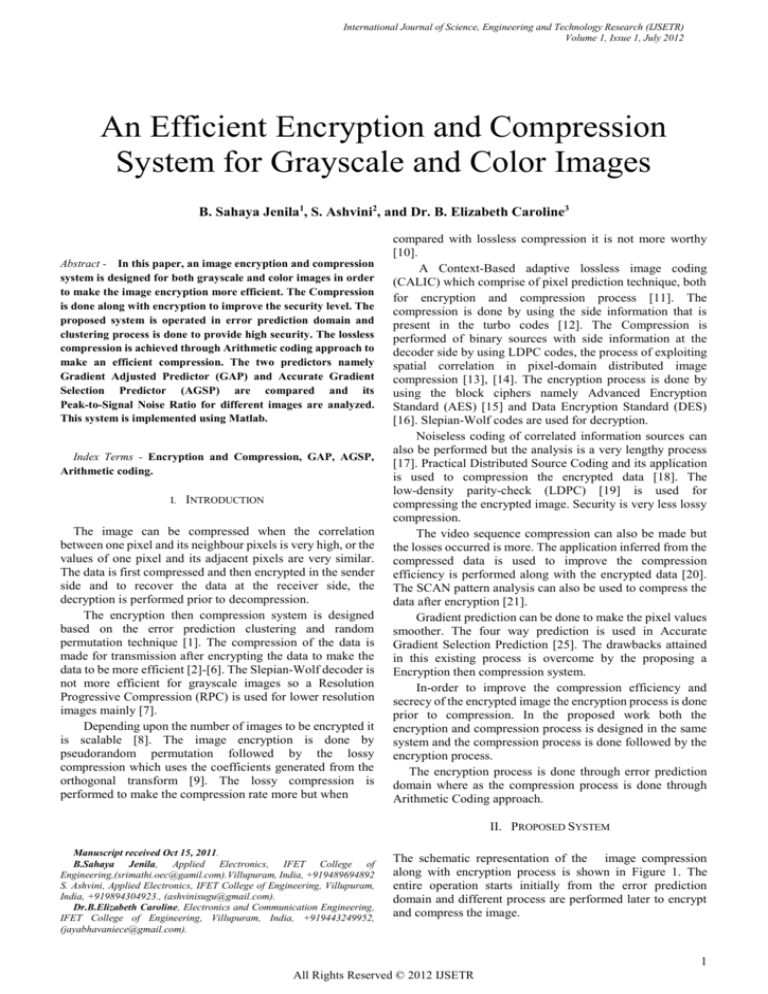
International Journal of Science, Engineering and Technology Research (IJSETR)
Volume 1, Issue 1, July 2012
An Efficient Encryption and Compression
System for Grayscale and Color Images
B. Sahaya Jenila1, S. Ashvini2, and Dr. B. Elizabeth Caroline3
Abstract - In this paper, an image encryption and compression
system is designed for both grayscale and color images in order
to make the image encryption more efficient. The Compression
is done along with encryption to improve the security level. The
proposed system is operated in error prediction domain and
clustering process is done to provide high security. The lossless
compression is achieved through Arithmetic coding approach to
make an efficient compression. The two predictors namely
Gradient Adjusted Predictor (GAP) and Accurate Gradient
Selection Predictor (AGSP) are compared and its
Peak-to-Signal Noise Ratio for different images are analyzed.
This system is implemented using Matlab.
Index Terms - Encryption and Compression, GAP, AGSP,
Arithmetic coding.
I.
INTRODUCTION
The image can be compressed when the correlation
between one pixel and its neighbour pixels is very high, or the
values of one pixel and its adjacent pixels are very similar.
The data is first compressed and then encrypted in the sender
side and to recover the data at the receiver side, the
decryption is performed prior to decompression.
The encryption then compression system is designed
based on the error prediction clustering and random
permutation technique [1]. The compression of the data is
made for transmission after encrypting the data to make the
data to be more efficient [2]-[6]. The Slepian-Wolf decoder is
not more efficient for grayscale images so a Resolution
Progressive Compression (RPC) is used for lower resolution
images mainly [7].
Depending upon the number of images to be encrypted it
is scalable [8]. The image encryption is done by
pseudorandom permutation followed by the lossy
compression which uses the coefficients generated from the
orthogonal transform [9]. The lossy compression is
performed to make the compression rate more but when
compared with lossless compression it is not more worthy
[10].
A Context-Based adaptive lossless image coding
(CALIC) which comprise of pixel prediction technique, both
for encryption and compression process [11]. The
compression is done by using the side information that is
present in the turbo codes [12]. The Compression is
performed of binary sources with side information at the
decoder side by using LDPC codes, the process of exploiting
spatial correlation in pixel-domain distributed image
compression [13], [14]. The encryption process is done by
using the block ciphers namely Advanced Encryption
Standard (AES) [15] and Data Encryption Standard (DES)
[16]. Slepian-Wolf codes are used for decryption.
Noiseless coding of correlated information sources can
also be performed but the analysis is a very lengthy process
[17]. Practical Distributed Source Coding and its application
is used to compression the encrypted data [18]. The
low-density parity-check (LDPC) [19] is used for
compressing the encrypted image. Security is very less lossy
compression.
The video sequence compression can also be made but
the losses occurred is more. The application inferred from the
compressed data is used to improve the compression
efficiency is performed along with the encrypted data [20].
The SCAN pattern analysis can also be used to compress the
data after encryption [21].
Gradient prediction can be done to make the pixel values
smoother. The four way prediction is used in Accurate
Gradient Selection Prediction [25]. The drawbacks attained
in this existing process is overcome by the proposing a
Encryption then compression system.
In-order to improve the compression efficiency and
secrecy of the encrypted image the encryption process is done
prior to compression. In the proposed work both the
encryption and compression process is designed in the same
system and the compression process is done followed by the
encryption process.
The encryption process is done through error prediction
domain where as the compression process is done through
Arithmetic Coding approach.
II. PROPOSED SYSTEM
Manuscript received Oct 15, 2011.
B.Sahaya Jenila, Applied Electronics, IFET College of
Engineering,(srimathi.oec@gamil.com).Villupuram, India, +919489694892
S. Ashvini, Applied Electronics, IFET College of Engineering, Villupuram,
India, +919894304923., (ashvinisugu@gmail.com).
Dr.B.Elizabeth Caroline, Electronics and Communication Engineering,
IFET College of Engineering, Villupuram, India, +919443249952,
(jayabhavaniece@gmail.com).
The schematic representation of the image compression
along with encryption process is shown in Figure 1. The
entire operation starts initially from the error prediction
domain and different process are performed later to encrypt
and compress the image.
1
All Rights Reserved © 2012 IJSETR
International Journal of Science, Engineering and Technology Research (IJSETR)
Volume 1, Issue 1, July 2012
I
+
Encode and
compress
∑
3
6
9
16
Ie
4
7
10
13
1
8
11
14
2
5
12
15
(b)Row shift
Prediction
Fig 2.(a)(b). Representation of clusters after cyclic shift operation
Fig 1. Encryption and compression system
A. Image Encryption Procedure
There are different steps involved in encryption of a image,
namely
Step 1: The pixel prediction for each image is done by
using the predictor GAP [11] and AGSP [26]. For each pixel
in image I, will be denoted as Ii,j so after the pixel prediction is
done the predicted values will be given as I͞͞ i,j.
Step 2: The difference between the actual pixel value
and predicted pixel value is determined and it is replaced on
the actual pixel. It is mapped within the range [0,255]. This
process is known as mapping.
̅
e = Ii,j − Ii,j
The key k value is predicted within the range 0 ≤ k ≤ 15. The
concatenation of the encrypted image is based on this range.
This process is known as random permutation.
Step 5: By using the assembler all the clusters values are
obtained in a encrypted bitstream Ie .
I
AGSP
Mapping
(1)
The value of a pixel can be accurately predicted using a
simple predictor of previously observed neighbour pixels.
Step 3: After the mapping of errors is done, the error
values are clustered into 16 groups, depending upon the error
values. This process is known as clustering.
Step 4: Each clusters are subjected to cyclic shift
operations namely column shift Ck and row shift Rk
separately.
A fixed key value is given in common to all the clusters
respectively.
Clustering
………
k
C1
C2
C16
Perm
utatio
n
C͞͞1
Permu
tation
k
k
……………
C͞͞2
Permu
tation
C͞͞16
……
1
5
9
13
2
6
10
14
3
7
11
15
4
8
12
16
Assembler
Ie
Fig.2 Actual representation of clusters
Fig 3. Image encryption operation
The initial stage of 16 cluster formation is shown in Fig.2.
The Column shift Ck is applied to the clusters initially
followed by the Row shift Rk. Fig.3 shows the cluster
representation after the cyclic shift operation is performed.
In Fig.3 the Schematic diagram for image encryption
process is given. A 16 bit data will be obtained as the
encrypted image. It is further subjected to compression.
B. Image Compression Procedure
Ck = [3 1 2 0]
13
1
5
9
14
2
6
10
11
15
3
7
(a) Column shift
4
8
12
16
At the compression stage the clusters C͞͞1 ,C͞͞2 , C͞͞3 ,…., C͞͞16
are segmented from the encrypted image Ie . In order to make
a lossless compression an Adaptive Arithmetic Coding
approach is followed. Since the random permutation changes
only the location the values remain unchanged. So,
depending upon the cluster values the bitstream B is
generated. The entire bitstream B is denoted as,
B = B1 B2 B3………….B16
(2)
Rk = [2 3 0 1]
2
All Rights Reserved © 2012 IJSETR
International Journal of Science, Engineering and Technology Research (IJSETR)
Volume 1, Issue 1, July 2012
The reason for going with lossless compression is that,
Lossy compression formats suffer from generation loss,
repeatedly compressing and decompressing the file will
cause it to progressively lose quality. This is in contrast with
lossless data compression, where data will not be lost via the
use of such a procedure. Due to this a loss less data can be
transferred from one place to other.
III . COMPARISON BETWEEN THE PREDICTORS
F
G
H
E
C
B
I
D
A
X
Fig 5. Causal template for AGSP
In AGSP, the pixel prediction is done in four directions
namely in horizontal, vertical, 45⁰ and -45⁰ as shown in
Figure 6.
A. Gradient Adjusted Predictor
The Gradient Adjusted Predictor (GAP) [11] is used to
achieve smoothness of the pixel values that are present in an
image. The pixel scanning is done to predict the pixel values.
The raster scanning is done.
Vertical
-45⁰
.
D
G
H
C
B
I
A
X
Horizontal
45⁰
Fig 4. Causal template for GAP
Fig 4. shows the general template for the Gradient
Adjusted Predictor. For a particular pixel X given in Fig 4.
the pixel prediction is done on both the horizontal and
vertical analysis. The dh and dv are the horizontal and vertical
pixel values that are predicted respectively. The d h and dv are
determined as,
dh = │a − d│ + │b − c│ + │b − i│
(3)
dv = │a − c│ + │b − g│ + │i − h│
(4)
By obtaining the difference between dh and dv using the
equation (3) and (4) the edges are predicted. There are three
different ranges for weak edge, normal edge and sharp edge
in both horizontal and vertical directions [11]. The value
obtained is known as the pixel predicted value. The
difference between this the actual pixel value and the
predicted pixel value is known as the error obtained.
B. Accurate Gradient Selection Predictor
The Accurate Gradient Selection Predictor (AGSP)
[25] is the proposed predictor that is used in the encryption
and compression system that is designed. The advantage of
AGSP over GAP is that it gives more accurate pixel predicted
values so that the rate of loss of the encrypted image will be
very less. The scanning of the pixel is done through raster
scanning method. The causal template for AGSP is shown in
Fig 5. In this X is the current pixel and the remaining
variables are the neighboring pixels.
Fig 6. Four direction Gradient Selection
The pixel prediction is determined by using the variables
dh , dv , dp , dn , Ch , Cv , Cp and Cn as shown in equations (5) –
(12) ,
dh = (2x│a-d│+2x│b-c│+2x│b-i│+│g-f│+│g-h│+│c-e│)
9+1
…..(5)
dv = (2x│a-c│+2x│b-g│+2x│i-h│+│d-e│+│c-f│)
7+1
(6)
dp = (2x│b-a│+2x│b-h│+2x│c-d│+│c-g│)
6+1
(7)
dn = (2x│a-e│+2x│b-f│+2x│i-g│)
5+1
(8)
Ch = a
(9)
Cv = b
(10)
Cp = i
(11)
Cn = c
(12)
By using the parameters obtained from the above
equations the predicted pixel value X͞ is calculated as,
̅=
X
(dmin 1 x Cmin 2 ) + (dmin 1 x Cmin 2 )
dmin 1 + dmin2
(13)
3
All Rights Reserved © 2012 IJSETR
International Journal of Science, Engineering and Technology Research (IJSETR)
Volume 1, Issue 1, July 2012
The equation 13, gives the value of the predicted pixel
and the difference between the actual pixel value and the
predicted pixel value gives the error value.
IV. RESULTS
The entire system is implemented through Matlab
software. The comparison between the GAP and AGSP
predictor is analyzed. A color image is chosen and it is
processed through both the predictors.
Fig 9. Mapped images of AGSP and GAP
The resolution of the image is determined through the
Peak-to-Signal Noise Ratio (PSNR). The resolution of the
reconstructed image depends upon the PSNR value. The
PSNR rate is calculated for both the predictors using the
formula,
PSNR =
10 x log
255∗255
MSE
log 10
(14)
The PSNR rate of the image processed through GAP is
5.9569 as analyzed from Fig. 10. But it is less when
compared to the PSNR rate that is obtained through AGSP
predictor.
Fig 7. Original image
Fig 7. shows the original image that is to be processed
through both the systems. Due to get an efficient processing
system color image is converted into grayscale initially and
further processing is done.
The converted grayscale image of the original image is
shown in Fig 8.
Fig 10. Features of an image obtained through GAP predictor
Fig 8. Converted grayscale image
The error values for all the corresponding pixel is calculated
and the mapping process is done through both the predictors
and the comparison between the two mapped images is
shown in Fig 9.
From Fig 11. It is proved that the PSNR rate of the image
is higher when compared with the image processed through
GAP predictor. The PSNR rate obtained through AGSP
predictor is 6.4219.
4
All Rights Reserved © 2012 IJSETR
International Journal of Science, Engineering and Technology Research (IJSETR)
Volume 1, Issue 1, July 2012
ACKNOWLEDGMENT
It’s our immense pleasure to express our deep sense of
gratitude and indebtedness to our highly respected and
esteemed Prof. B. Elizabeth Caroline (ECE) Department
IFET College of Engineering, Tamilnadu. Her invaluable
guidance, inspiration, constant encouragement sincere
criticism and sympathetic attitude could make this paper
possible.
REFERENCES
[1]
[2]
[3]
[4]
Fig 11. Features of an image obtained through AGSP predictor
[5]
[6]
The Table 1 shows the entire comparison between the
two GAP and AGSP predictor in general.
Table I. Comparison between GAP and AGSP
[7]
[8]
Parameters
GAP
AGSP
MSE
1.6496e+04
1.6103e+04
PSNR
5.9569
6.0619
dh
3
2.7778
dv
10
2.2857
dp
-
4
dn
-
3.4000
Cn
-
46
Cp
-
44
Ch
-
47
[15]
Cv
-
45
[16]
[9]
[10]
[11]
[12]
[13]
[14]
[17]
V. CONCLUSION
[18]
In this paper, an efficient image encryption and compression
system is proposed through the error prediction domain and
random permutation by using a new Accurate Gradient
Selection Predictor. It is also proved that the new proposed
predictor is more efficient than the Gradient Adjusted
Predictor by calculating its Peak-to-Signal Noise ratio. The
security of transmitting the encrypted images can be
improved more through this proposed system.
[19]
[20]
[21]
[22]
[23]
Jiantao Zhou, Xianming Liu, Oscar C. Au, and Yuan Yan
Tang,”Designing an Efficient Image Encryption-Then-Compression
System via Prediction Error Clustering and Random Permutation”
IEEE transactions on information forensics and security, vol. 9, no.
1,pp 39-50 January 2014
J. Zhou, X. Liu, and O. C. Au, “On the design of an efficient
encryptionthen-compression system,” in Proc. ICASSP, 2013, pp.
2872–2876.
M. Johnson, P. Ishwar, V. M. Prabhakaran, D. Schonberg, and K.
Ramchandran, “On compressing encrypted data,” IEEE Trans. Signal
Process., vol. 52, no. 10, pp. 2992–3006, Oct. 2004.
D. Schonberg, S. C. Draper, and K. Ramchandran, “On compression of
encrypted images,” in Proc. IEEE Int. Conf. Image Process., Oct.
2006,pp. 269–272.
R. Lazzeretti and M. Barni, “Lossless compression of encrypted
greylevel and color images,” in Proc. 16th Eur. Signal Process.
Conf.,Aug. 2008, pp. 1–5.
A. Kumar and A. Makur, “Distributed source coding based encryption
and lossless compression of gray scale and color images,” in
Proc.MMSP, 2008, pp. 760–764.
W. Liu, W. J. Zeng, L. Dong, and Q. M. Yao, “Efficient compression
of encrypted grayscale images,” IEEE Trans. Imag. Process., vol.
19,no. 4, pp. 1097–1102, Apr. 2010.
X. Zhang, G. Feng, Y. Ren, and Z. Qian, “Scalable coding of encrypted
images,” IEEE Trans. Imag. Process., vol. 21, no. 6, pp.
3108–3114,Jun. 2012.
A. Kumar and A. Makur, “Lossy compression of encrypted image by
compressing sensing technique,” in Proc. IEEE Region 10
Conf.TENCON, Jan. 2009, pp. 1–6.
X. Zhang, “Lossy compression and iterative recobstruction for
encrypted image,” IEEE Trans. Inf. Forensics Security, vol. 6, no. 1,
pp. 53–58,Mar. 2011.
X. Wu and N. Memon, “Context-based, adaptive, lossless image
codec,” IEEE Trans. Commun., vol. 45, no. 4, pp. 437–444, Apr. 1997.
A. Aaron and B. Girod, "Compression with side information using
turbo codes," in Proc. IEEE Dala Compression Conj, Snowbird, UT,
Apr. 2002, pp. 252-26.
A. Liveris, Z. Xiong, and C. Georghiades, "Compression of binary
sources with side information at the decoder using LDPC codes," IEEE
Commun. Lett. vol. 6, no. 10, pp. 440--442, Oct.2002.
D. Varodayan, A. Aaron, and B. Girod, "Exploiting spatial correlation
in pixel-domain distributed image compression," in Proc. Picture
Coding Symposium, Beijing, China, Apr. 2006.
Advanced Encryption Standard (AES), FIPS PUB 197, Gaithersburg,
MD, Denmark, Nov., 2001
Data Encryption Standard (DES), FIPS PUB 197, Washington, DC,
1977.
D. Slepian and J. Wolf, “Noiseless coding of correlated information
sources,” IEEE Trans. Inf. Theory, vol. IT-19, no. 4, pp. 471–480,
Jul.1973.
D. Schonberg, “Practical Distributed Source Coding and its
Application to the Compression of Encrypted Data,” Ph.D.
dissertation, Univ. California, Berkeley, 2007.
R. G. Gallager, “Low Density Parity Check Codes,” Ph.D. dissertation,
Mass. Inst. Technol., Cambridge, MA, 1963.
D. Schonberg, S. C. Draper, C. Yeo, and K. Ramchandran, “Toward
compression of encrypted images and video sequences,” IEEE Trans.
Inf. Forensics Security, vol. 3, no. 4, pp. 749–762, Dec. 2008.
N. Bourbakis and C. Alexopoulos, “Picture data encryption using
SCAN patterns,” Pattern Recognit., vol. 25, no. 6, pp. 567–581, 1992.
A. Moffat, R. Neal, and I. Witten, “Arithmetic coding revisited,” in
Proc. Data Compression Conf., J. A. Storer and M. C. Cohn, Eds.,
1995, pp.202–211.
M. J. Weinberger, J. J. Rissanen, and R. B. Arps, “Applications of
universal context modeling to lossless compression of
5
All Rights Reserved © 2012 IJSETR
International Journal of Science, Engineering and Technology Research (IJSETR)
Volume 1, Issue 1, July 2012
gray-scaleimages,” IEEE Trans. Image Processing, vol. 5, pp.
575–586, Apr. 1996.
[24] X. Wu, “Lossless compression of continuous-tone images via context
selection, quantization, and modeling,” IEEE Trans. Image
Processing,vol. 6, May 1997.
[25] Abdolrahman Attar , Reza Moradi Rad and Asadollah Shahbahrami
“An Accurate Gradient-Based Predictive Algorithm for Image
Compression”, MoMM2010 Proceedings.
[26] J. Knezovic and M. Kovac, “Gradient Based Selective Weighting of
Neighboring Pixels for Predictive Lossless Image Coding” 25th Int.
Conf. on Information Technology Interfaces, June 2003.
BIOGRAPHY
B.Sahaya Jenila was born in Tamilnadu on 1992. She is a M.E.
student of Applied Electronics department in IFET College of
Engineering, Villupuram, India. She completed her Bachelor of
degree in Electronics and Communication Engineering in Sri
Manakula Vinayagar Engineering College, Puducherry, India in the
year 2013.
S.Ashvini was born in Tamilnadu on 1992. She is a M.E. student of
Applied Electronics department in IFET College of Engineering,
Villupuram, India. She completed her Bachelor of degree in
Electrical and Electronics Engineering in Sri Manakula Vinayagar
Engineering College, Puducherry, India in the year 2013.
Dr. B. Elizabeth Caroline, M.E., Ph.D., is a Electronics and
Communication Engineering graduate of 1992 Batch from Karunya
Institute of Technology, Coimbatore .She obtained her Master
degree in Communication systems in the year 1999 from Regional
Engineering College (NIT), Trichy. She was awarded Ph.D.
(Optical signal processing) by Anna University, Chennai, Tamil
Nadu, India in 2010. She is having concurrent Teaching, Research
and Industrial experience of two decades. She is working as a
Professor of ECE department. She has published research papers in
International Journals, National and International Conferences. Her
areas of interest include digital signal processing, image processing,
optical signal processing and optical computing. She is an active
member of IEEE and a life member of ISTE and BES (Broad
casting Engineers Society) .She is a recognized supervisor under the
faculty of Information and Communication Engg, Anna University ,
Thiruchirapalli. She is guiding 2 research scholars in the area of
image processing and wireless sensor network. She is acting as
Doctoral Committee members for 2 research scholars. She is
reviewer for few reputed international journals .She served
as Chair-Person, Resource Person, Key Note Speaker for national
and International Conferences. She visited Australia and
Singapore.
6
All Rights Reserved © 2012 IJSETR

